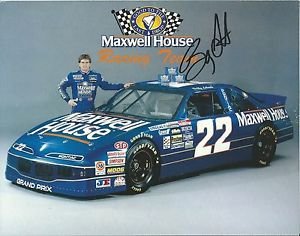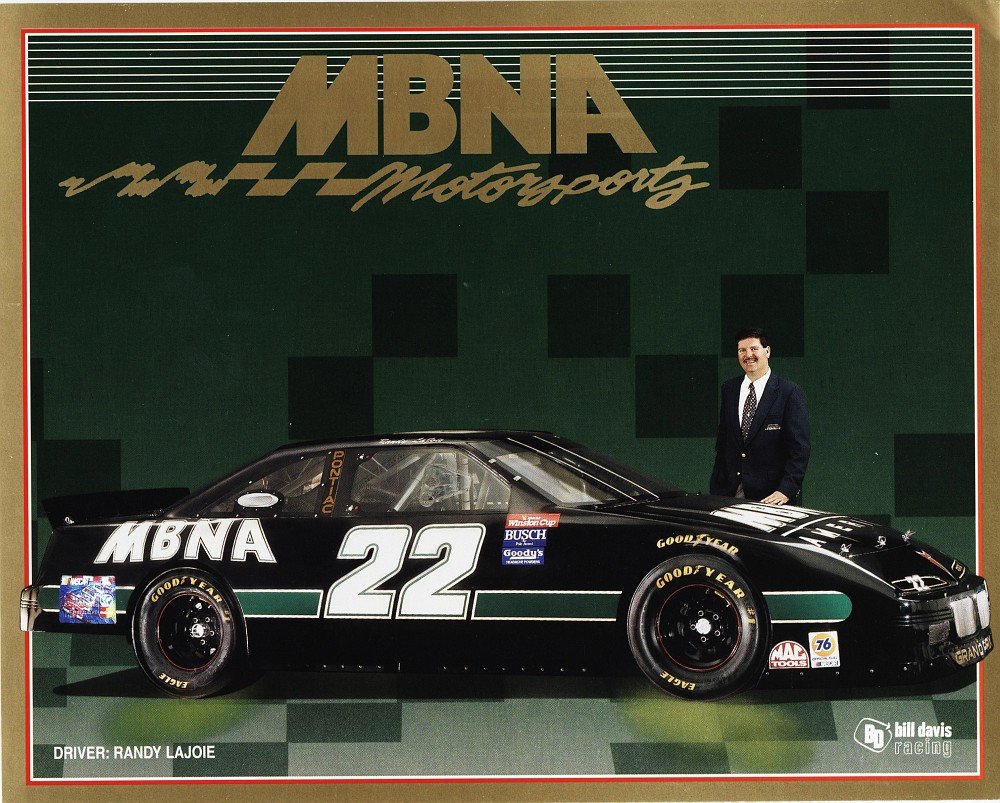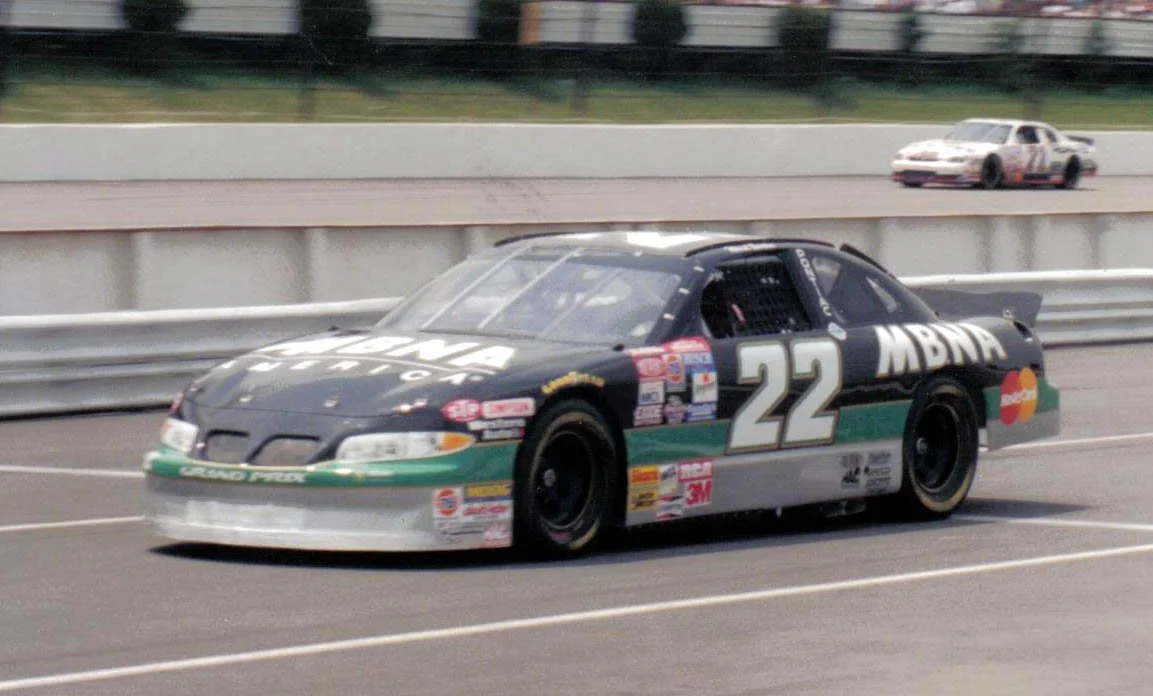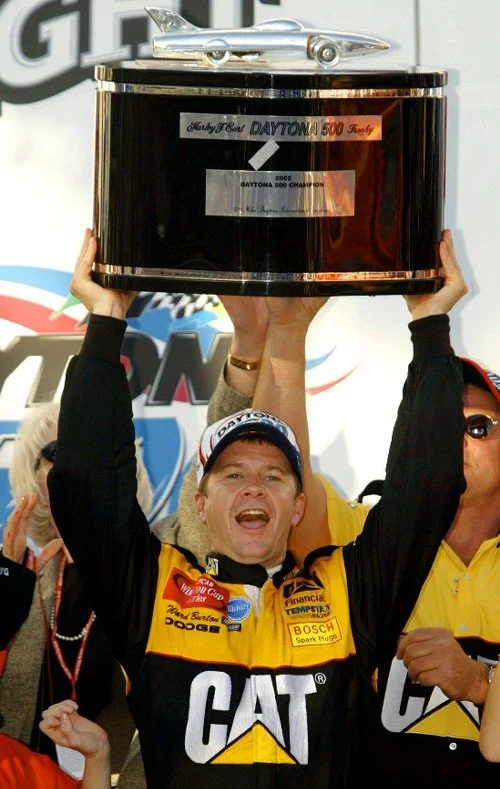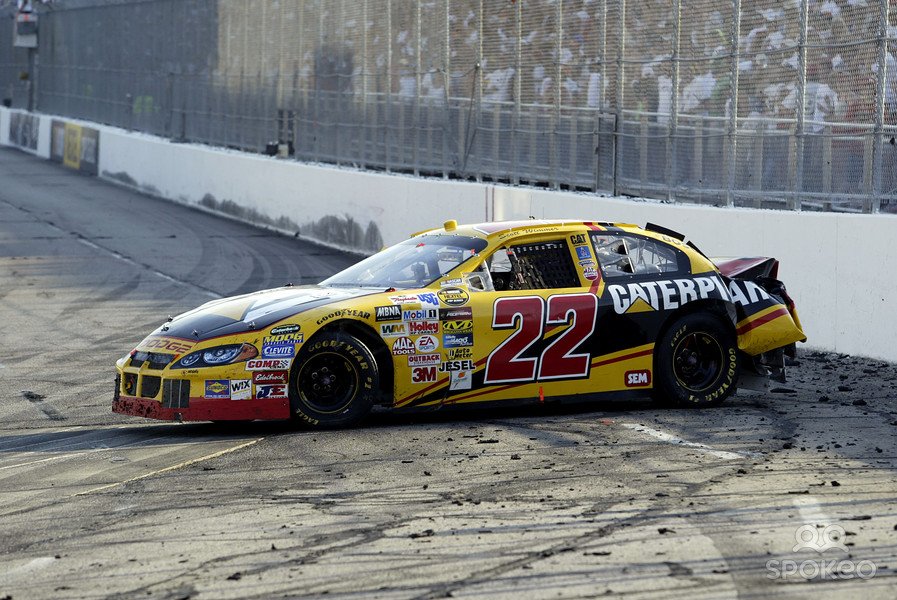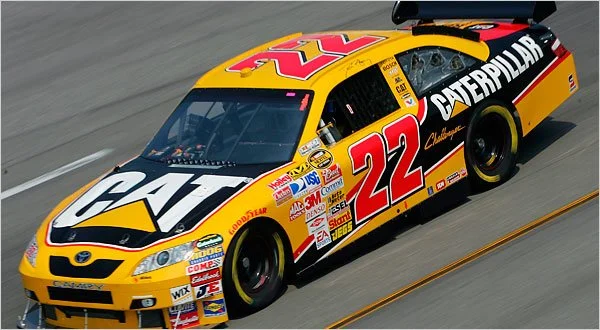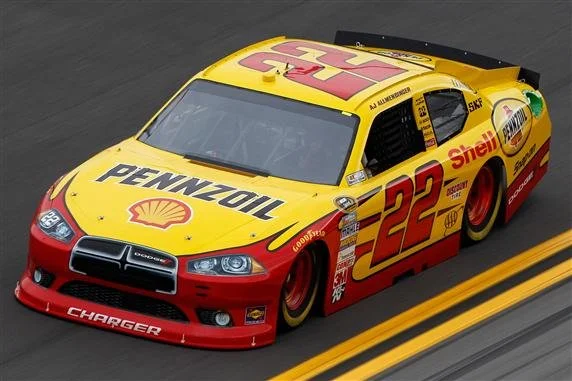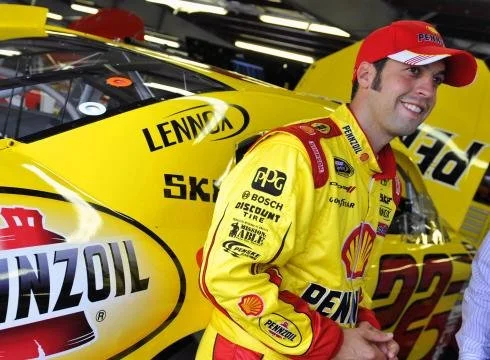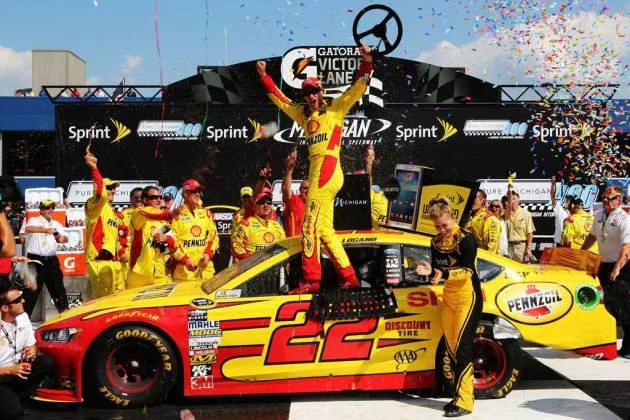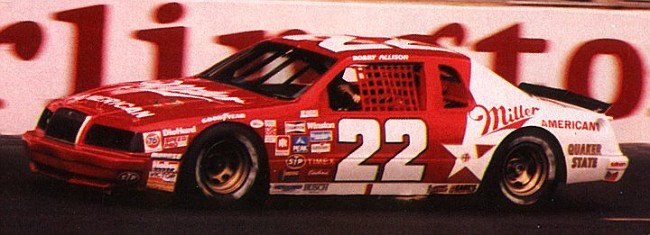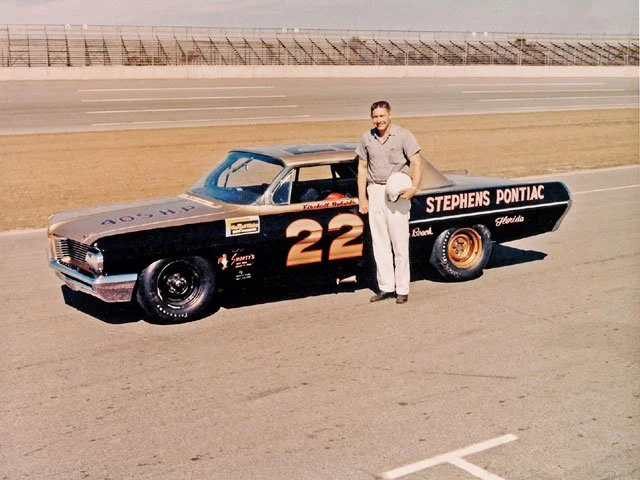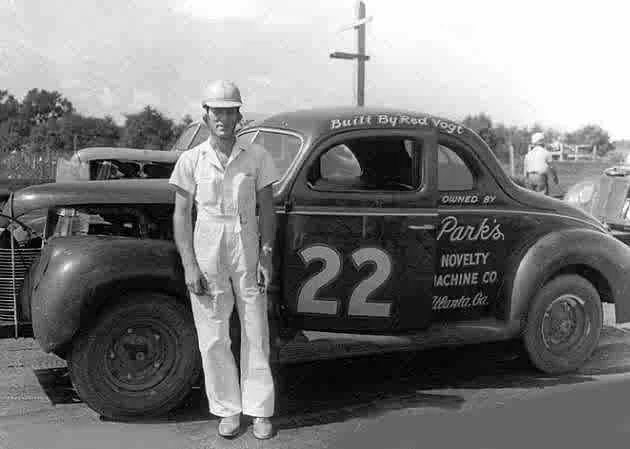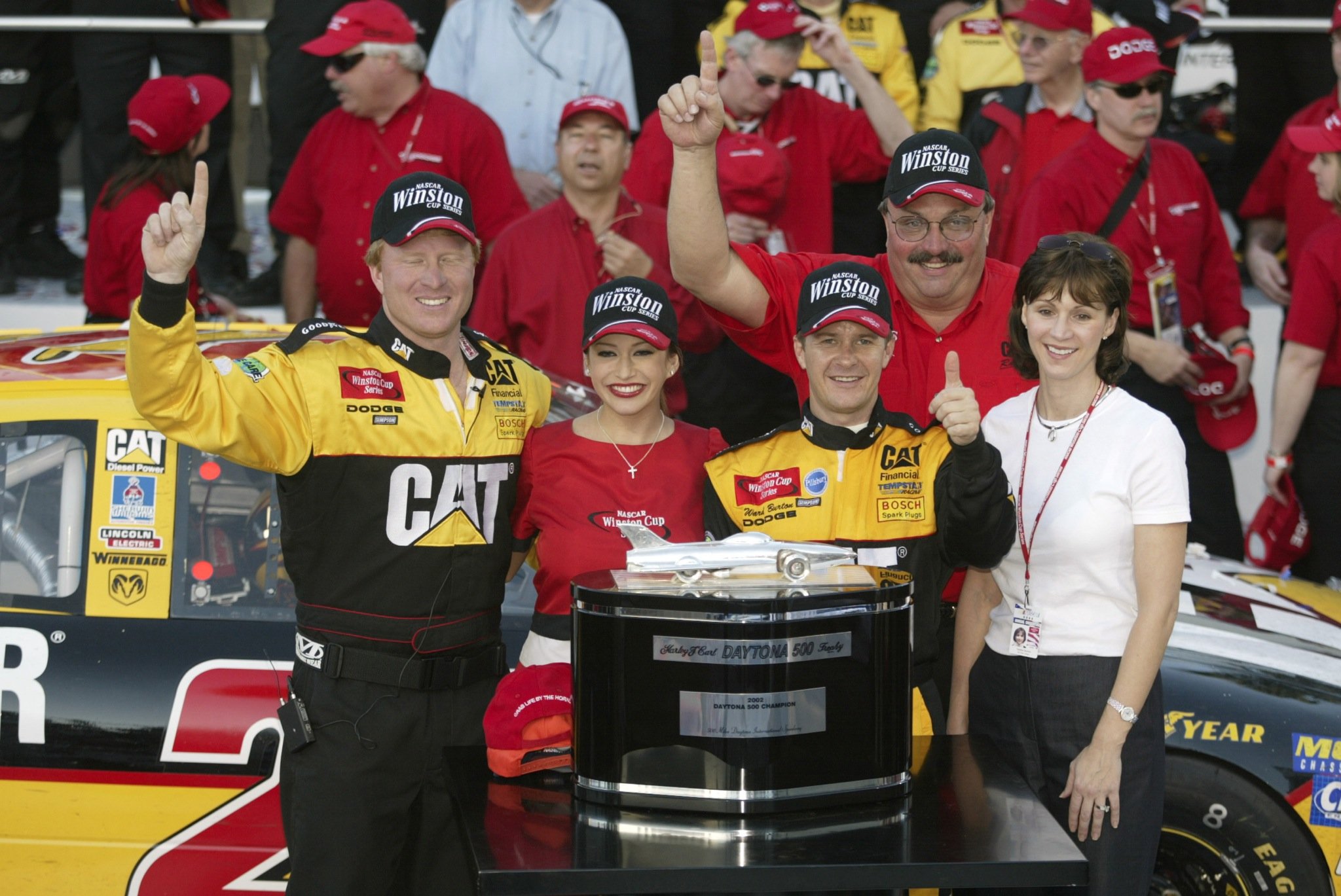
In Cup Series competition the #22 car has started 1,671 races and has 88 wins, 82 poles, 407 top 5s, and 686 top 10s.
In 1990 Bill Davis was asked by the Ford Motor Company to hire an up-and-coming Midwest driver Jeff Gordon. Gordon won the NASCAR Busch (XFINITY) Series Rookie of the Year in 1991, and won 3 races & 11 pole positions the next year. Davis was hoping to move Gordon and crew chief Ray Evernham to the Winston Cup Series in the #22 car, but they were lured away by Rick Hendrick. Davis still moved up to the Cup Series full-time in 1993 however, with driver Bobby Labonte, who finished runner up to Gordon for Rookie of the Year driving the #22 Maxwell House Ford. The team switched to Pontiac the following season. From 1993-1994 Bobby started the car in 61 races. After 1994, Labonte left for Joe Gibbs Racing.
MBNA replaced Maxwell House as sponsor. Originally, Davis went with another rookie and Busch Series standout Randy LaJoie to drive the car . Midway through the year, LaJoie was fired from the team and replaced by a series of rotating drivers including Wally Dallenbach, who finished 2nd at Watkins Glen.
Finally, Ward Burton was hired to finish out the year. Ward has 272 starts in #22 from 1995-2003 including 5 wins. He scored the team’s first win at North Carolina Motor Speedway late in 1995. With Burton at the wheel the #22 team slowly began to improve, despite not winning races. By 1998 the #22 team cracked the top ten in the final Winston Cup (Cup Series) points standings and matched those results in 1999 (by which time Caterpillar , Inc. was sponsoring the team) and 2000, when the team finally returned to victory lane at the spring Darlington race. Burton’s second career win was BDR’s last win in a Pontiac as they joined several teams in switching to Dodge Intrepids for the following season.
Burton returned to victory lane the following season, winning the 2001 Southern 500, Dodge’s second win since returning to NASCAR, but the team’s streak of consecutive top-ten points finishes was broken at three as the #22 finished 14th. He added two more wins in 2002, scoring a victory in the Daytona 500 (Dodge’s first Daytona 500 win in 28 years) and later in the year at the New England 300 at New Hampshire, but a series of inconsistent finishes dropped the team to 25th in the final standings. Burton’s win at New Hampshire, in addition to being his last win in Cup racing, was also BDR’s last in Cup racing. 2003 was a season of poorer finishes. He only had 4 Top 10 finishes, and he left Bill Davis Racing with five races left in the season to begin driving the #0 NetZero Pontiac for Haas CNC Racing. He finished the season 21st in the final points standings. Ward is an avid sportsman and conservationist, is the founder and president of The Ward Burton Wildlife Foundation.
Scott Wimmer was promoted from Bill Davis’ Busch (XFINITY) Team to drive the #22 car following Ward Burton’s departure near the end of the 2003 season. From 2003-2005 Wimmer started 75 races earning only 1 top 5.
For 2006 Dave Blaney, a former driver of Bill Davis’ #93 car, was hired back by Davis to take over the #22 ride. Dave made 104 starts in #22 from 2006-2008. Blaney won the pole for the 2007 Lenox Industrial Tools 300 in New Hampshire, the first pole for Toyota in the Cup Series. Blaney scored his first top 10 with Toyota at Indianapolis Motor Speedway on July 29, and later that season finished third at Talladega, the best finish of any Toyota in 2007. Additionally, Blaney was the only Toyota driver in the top 35 in owner points after 2007 season.The team had a rough start to the 2008 season. They missed the Aaron’s 499 which was a hard hit for the team. They came back the next week at Richmond to finish in the 18th position. The following week at Darlington they finished in the 9th position, their best of the year. In June 2008 Caterpillar announced that it would leave the #22 Bill Davis Racing Toyota to sponsor the #31 Richard Childress Racing starting in 2009. The lack of sponsorship eventually lead to the demise of Bill Davis Racing.
In 2011 Kurt Busch began driving the #22 after Brad Keselowski took over the #2 car at Penske Racing. In 36 starts Busch won 2 races in the number during the 2011 season. Busch earned his first Budweiser Shootout (Clash) win after Denny Hamlin went below the yellow line at the end of the race at Daytona. He would go on to win the 2011 Gatorade Duel 1, and because of polesitter Dale Earnhardt, Jr.’s crash in practice, which forced him into a backup car, Busch started in first for the 2011 Daytona 500, and started the 2011 season 3 for 3.
Busch won the pole for and led most of the race at Kansas, for 152 laps. However, a fuel pickup issue late hurt his chances of winning. Teammate Brad Keselowski took the victory. However, a few weeks later on June 26, Kurt finally got an elusive road course victory at Infineon Raceway. Not only did he win, but he also led the most laps with 76. Because of Brad Keselowski’s injury during a practice crash at Road Atlanta, Busch filled in for Keselowski in his NASCAR Nationwide Series car for the Zippo 200 at Watkins Glen International, and Busch managed to get the pole and the win. By August 13, 2011, Busch had won 1/4 of all of his Nationwide races. On October 2, Busch won on 2 late restarts beating Jimmie Johnson in turn 1 leading the final 43 laps to grab his first ever victory at the Monster Mile at Dover. After a frustrating final 5 races, things came to a head when Busch launched a verbal tirade against an ESPN cameraman, and giving an obscene gesture to workers when a car blocked his path towards his pit garage following a transmission failure at the same race. Busch’s employment with Penske Racing terminated on December 5, 2011. Although most observers of the sport believe he was fired, Busch claimed in a public statement that the parting was “mutual”: “I am grateful to Penske Racing for six very productive years. Together we won a lot of races — 16 in all. … Coming to a mutual agreement to go our separate ways is a positive step for me.” In contrast, the Charlotte Observer reported several sources confirming team owner Roger Penske decided that Busch’s altercation at Homestead-Miami Speedway was the last straw in his stormy tenure with the team but chose to defer the announcement until after Champion’s Week
A.J Allmendinger started the #22 car 17 times in 2012. At the end of the 2011 season, Allmendinger left Richard Petty Motorsports when the driving spot for Penske Racing’s #22 Shell/Pennzoil Dodge became open after the parting ways of Kurt Busch and Penske. Prior to his suspension, his best finish was a 2nd at Martinsville Speedway. After failing a random drug test on July 7, 2012, Allmendinger was suspended from participation in the Coke Zero 400. Steve O’Donnell, NASCAR’s senior vice president for racing operations, said that Allmendinger had up to 72 hours to request a ‘B’ test sample. The next day, Roger Penske said before the Honda Indy Toronto race that Allmendinger’s ‘B’ sample would be tested on Monday or Tuesday. Allmendinger requested a ‘B’ sample test on July 9. On July 11, 2012, Allmendinger’s camp said a stimulant caused the positive drug test. The B sample test had not yet been scheduled at that time.
On July 24, it was announced by NASCAR that Allmendinger was suspended indefinitely after the “B” sample tested positive for a banned stimulant, which was revealed to be amphetamines. He chose to participate in the Road to Recovery program. On August 1, he was released from his contract by Penske Racing. Allmendinger was replaced in the No. 22 by Sam Hornish Jr. for the remaining 19 races of the season; he later stated that the cause of the positive test was Adderall that he had unknowingly taken, being told it was an “energy pill”. Allmendinger was reinstated by NASCAR on September 18 after completing the Road to Recovery program.
On September 4, 2012, Joey Logano was announced to be the driver of the No. 22 car in 2013. Logano became the fourth driver of the No. 22 in three years, but had a successful 2013 season, making the Chase, and returned in 2014, becoming the first driver to return to the No. 22 Penske car for more than a single season. In 2014 he was one of the final 4-title contenders heading into the final round of the Chase for the Cup. However, he wound up last of the final four following some mistakes made by his pit crew and could only produce a 16th place finish. Kevin Harvick went on to win the title.
Logano and Penske teammate Brad Keselowski were the dominant force for much of the 2015 Chase for the Cup, and Logano swept the entire 2nd round with 3 consecutive victories. His victory at Kansas came at the expense of Matt Kenseth who was spun by Logano in the closing laps. After leading much of the day at Martinsville, Logano was wrecked by Kenseth as a retaliation. Logano would not recover in the next 2 races and would be elminated in the 3rd round.
In 2016, Logano qualified for The Chase with a win at Michigan. It would be his only win in the regular season. Logano had mixed success throughout the regular season, earning 9 top-10 finshes in addition to DNFs at Talladega, Kansas, & Kentucky.
Logano led 45 laps at Homestead and had a significant chance to win his first Cup series championship. With 10 laps left, Logano moved under leader Carl Edwards and wrecked Edwards on the restart. After a 30-minute red flag, Logano’s car was too damaged to contend any further and Logano finished the race in 4th place, finishing second in the standings to Jimmie Johnson.
In 2017 Logano would win in his 300th career start, the Spring race at Richmond. However, Logano’s car was discovered to have a rear suspension issue, forcing NASCAR to declare his victory an “encumbered” win; as a result, while his win was not stripped, it did not allow him to lock a spot into the playoffs. After a series of bad races, Logano missed the playoffs by one spot, finishing behind Kyle Larson after having finished 2nd at Richmond. This is the first time Logano missed the playoffs since his last year with Joe Gibbs Racing in 2012. He would finish 17th in the final standings.
2018 was a very quiet but productive year for “Sliced Bread.” Logano started the season with a second place finish in the Clash. He followed that up with a second place finish in his duel, losing to teammate Ryan Blaney. Logano had his ups and downs at the 2018 Daytona 500 with a tire rub and a pit penalty but rebounded to finish fourth after avoiding a wreck with two laps left. At the 2018 GEICO 500, he held off Kurt Busch to win the race and lock him in the Playoffs.
While the “Big Three” were making all the noise, Logano was quietly and patiently posting one of his best ever seasons. He had finished every race up until the Daytona summer race, where he was involved in one of the pile-ups triggered by Ricky Stenhouse Jr. Then weeks later he finished dead last for only the second time in his career at Watkins Glen. Early in the race, he had been going through the carousel before breaking an oil pan. Crew Chief Todd Gordon misinterpreted the crash-clock rules, forcing an end to Logano’s day early for the first time at The Glen in his career.
Logano became the evident flag bearer for his team. after the fall Kansas race, Logano became the sole Team Penske driver in the Round of 8 of the Playoffs after teammates Keselowski and Blaney were eliminated. entering the round of 8, Logano had a must-win mentality to make it to Homestead. He won the fall Martinsville raceafter a fierce battle with Martin Truex Jr. towards the finish line and secured his spot in the Championship 4. He dominated leading over 300 laps to secure his first Grandfather clock.
As the sun fell and the lights came on, Logano won at Homestead and became the 2018 Monster Energy NASCAR Cup Series Champion after out-driving the big three on the final restart.
In 2019, he started 4th at the Daytona, starting off the season as a strong contender for the championship. Logano battled back and forth for the win all day, such as avoiding “The Big One” that took out 21 other drivers, but came up short to a 1-2-3 finish with the Joe Gibbs Racing team. After the race, Logano had confronted fellow Ford driver Michael McDowell for not giving Logano the push he needed for the win. He left Daytona second in points, tied for the points lead with Denny Hamlin.
Logano would have a great start to the year with wins at Las Vegas and Michigan qualifying him for The Playoffs. Unfortunately, he never found victory lane again, and he would be eliminated in the Round of 8.
Logano started off 2020 with 2 wins in the first 4 races, prior to the COVID-19 hiatus. Logano would win again when it counted most, at Kansas to punch his ticket into the Championship 4 at the season finale at Phoenix. Logano ultimately placed 3rd in the championship race behind new champion Chase Elliott.
2021 proved to be an exciting year for Logano. He was leading on the final lap of the Daytona 500, before a crash with teammate Brad Keselowski allowed Michael McDowell to sneak through the carnage for the win. Logano would rebound to win the inaugural Bristol Dirt race, his lone win on the year, before experiencing another wild crash at Talladega. Logano got into the playoffs with his Bristol win. He made it all the way to the Round of 8 before being eliminated after Martinsville. He finished the season 8th in the points standings.
Logano began the 2022 season by winning the 2022 Busch Light Clash at The Coliseum. He scored his first points-paying win of the season at Darlington by bumping William Byron to the wall with two laps to go, infuriating both Byron and the crowd. Logano scored his second win of the season at the inaugural Gateway race. During the playoffs, he won at Las Vegas to make the Championship 4, before winning at Phoenix to claim his second Cup Series championship.
Logano won only one race in 2023- Atlanta in the spring. This would earn him a spot in The Playoffs, though he would be eliminated in the Round of 16.
Logano has started 396 races in car #22 with 30 wins. He will return in 2024.
Bobby Allison drove the #22 in 215 races in 1966, 1969-1970, & 1983-1987 with 17 wins and the 1983 Winston Cup Championship.
Fireball Roberts started #22 in 151 of his 206 career races including 30 of his 33 wins. Roberts continued to amass victories on the circuit, despite the changes in NASCAR, as it moved away from shorter dirt tracks to superspeedways in the 1950s and 1960s. In his 206 career NASCAR Grand National races, he won 33 times and had 32 poles. He finished in the top-five 45 percent of the time. He won both the Daytona 500 and Firecracker 250 events in 1962, driving a black and gold 1962 Pontiac built by car builder legend, Smokey Yunick. On May 24, 1964, at the World 600 in Charlotte, Roberts had qualified in the eleventh position and started in the middle of the pack. On lap seven, Ned Jarrett and Junior Johnson collided and spun out and Roberts crashed trying to avoid them. Roberts’ Ford slammed backward into the inside retaining wall, flipped over and burst into flames. Witnesses at the track claimed they heard Roberts screaming, “Ned, help me”, from inside his burning car after the wreck. Jarrett rushed to save Roberts as his car was engulfed by the flames. Roberts suffered second- and third-degree burns over eighty percent of his body and was airlifted to a hospital in critical condition. Although it was widely believed that Roberts had an allergic reaction to flame-retardant chemicals, he was secretly an asthmatic, and the chemicals made his breathing worse. Roberts was able to survive for several weeks, and it appeared he might pull through. But Roberts’ health took a turn for the worse on June 30, 1964. He contracted pneumonia and sepsis and had slipped into a coma by the next day. “Fireball” Roberts died from his burns on July 2, 1964.
Before the team was sold to Bill Davis Racing Sterling Marlin drove the #22 Maxwell House Ford for Junior Johnson for 58 races between 1991-1992.
Ricky Rudd ran a few races in 1976 and full-time in 1977, again driving the #22 for his father. He had ten top-ten finishes and was named Rookie of the Year. Rudd was forced to run part-time the following season of 1979 after picking up only limited funding from 1st National City Travelers Checks. Despite the abbreviated schedule, he earned four top-tens and finished 31st in points. Rudd started #22 at total of 45 times.
Red Byron drove #22 a total of 11 times from 1949-1951. His 2 wins in the 1949 season propelled him to the first ever NASCAR Strictly Stock (Cup Series) Championship.
Dick Brooks , 17 starts, 1 win
Art Watts , 7 starts, 1 win
Stan Barrett, 10 starts
Marvin Panch, 4 starts.
Grant Adcox, 3 starts.
Darrell Waltrip, 1 start
Lennie Pond, 1 start
Glen Wood, 1 start
